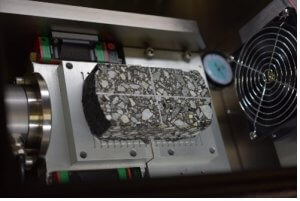Understanding the sensitivity and variability of pavement performance tests to asphalt mixture constituent and production parameters are critical steps for the asphalt industry to further adopt balance mix designs. CAIT researchers at the Rutgers Asphalt Pavement Lab are leading the charge.
Rutgers Center for Advanced Infrastructure and Transportation (CAIT) was awarded a new project from the National Cooperative Highway Research Program (NCHRP) to evaluate the sensitivity of Balance Mix Design performance tests.
Hamburg wheel tracking test for rutting.
Balanced Mix Design (BMD) is an approach to designing asphalt mixtures that uses performance-based tests to simulate real-world pavement distresses such as rutting, cracking, and moisture damage. BMD differs from traditional mix design methods that are volumetric-based, instead prioritizing laboratory mixture performance that relates to pavement performance in the field.
As state agencies and industry move to adopt BMD into their operations, questions still need to be addressed about the relative sensitivity of certain mechanical performance tests to variables in the asphalt mixtures.
“Currently there is limited understanding of how variations in the materials used in asphalt mixtures — like the types of recycled materials or the quality of the binder — affect the test outcome of these performance tests,” said Dr. Tom Bennert, Principal Investigator and Director of the Rutgers Asphalt Pavement Lab.
Tests methods simulating rutting, fatigue cracking, low temperature cracking and moisture damage will be evaluated for their sensitivity to different materials and methods during this project, with the goal of identifying key material and production parameters that are picked up in the test method and respective test outcome.
Joining the Rutgers team is Dr. Walaa Mogawer from the University of Massachusetts-Dartmouth and Ramon Bonaquist of Advanced Asphalt Technologies serving as Co-PI’s, and Dr. Don Christensen of Advanced Asphalt Technologies providing technical support.
Together, this team has decades of combined experience conducting and analyzing mechanical performance testing on a wide range of conventional to specialty asphalt mixtures containing additives, modifications, recycled asphalt, and mixture design and plant production variations.

Overlay tester for fatigue cracking.
Locally, Dr. Bennert helped to develop, implement, and maintain the BMD framework for the New Jersey Department of Transportation. He has also conducted BMD benchmarking projects for New York State Department of Transportation and the Pennsylvania Department of Transportation and helped recommended a BMD approach for the New England Transportation Consortium (NETC).
The knowledge gained from this study can help transportation agencies nationwide in adopting BMD more effectively. This research can also aid in the development standards and procedures for mechanical performance tests with organizations like the American Association of State Highway and Transportation Officials (AASHTO).
“BMD done right can allow us to optimize asphalt mix designs for performance and cost,” said Dr. Bennert. “Ensuring the accuracy of BMD performance tests is a critical step in making sure state transportation agencies get the most confidence and value out of the materials they use to build our roads and infrastructure.”

